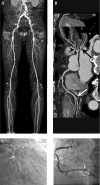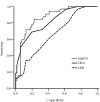Lower Extremity Arterial Calcification as a Predictor of Coronary Atherosclerosis in Patients with Peripheral Arterial Disease
- PMID: 27703657
- PMCID: PMC5037928
- DOI: 10.5812/iranjradiol.33179
Lower Extremity Arterial Calcification as a Predictor of Coronary Atherosclerosis in Patients with Peripheral Arterial Disease
Abstract
Background: Until now, there has been no study on the relationship between the calcification of the lower extremity arteries and significant coronary arterial disease (CAD).
Objectives: To evaluate whether lower extremity calcium scores (LECS) are associated with CAD and whether this can predict multivessel-CAD in patients with peripheral arterial disease (PAD).
Patients and methods: We retrospectively enrolled 103 PAD patients without cardiac symptoms or known CAD. All patients underwent cardiac computed tomography (CT) and lower extremity CT within 1 month and were categorized as nonsignificant CAD, single-CAD, or multivessel-CAD. The coronary calcium scores (CCS) were quantitatively measured according to the Agatston method and LECS were semi-quantitatively measured according to the presence of lower extremity calcification in the segment. The extent of CAD was evaluated according to the presence of ≥ 50% luminal diameter stenosis in the segment of CAD.
Results: LECS in multivessel-CAD were significantly higher than those in nonsignificant CAD (10.0 ± 5.8 versus 4.0 ± 3.1, P < 0.001). LECS significantly correlated with CCS (r = 0.831, P < 0.001) and the extent of CAD (r = 0.631, P < 0.001). Multivariate regression analysis demonstrated LECS and log-transformed CCS were independent predictors for multivessel-CAD. In receiver operating characteristic curve analysis, the diagnostic performance of LECS was 0.807 (95% confidence interval = 0.724-0.891, P < 0.001) for predicting multivessel-CAD.
Conclusion: Peripheral arterial calcification is significantly correlated with CAD extent in patients with PAD. Peripheral arterial calcification can be a useful marker for predicting multivessel-CAD.
Keywords: Atherosclerosis; Coronary Artery Disease; Multidetector Computed Tomography; Peripheral Arterial Disease; Vascular Calcification.
Figures


References
-
- Lange S, Trampisch HJ, Haberl R, Darius H, Pittrow D, Schuster A, et al. Excess 1-year cardiovascular risk in elderly primary care patients with a low ankle-brachial index (ABI) and high homocysteine level. Atherosclerosis. 2005;178(2):351–7. doi: 10.1016/j.atherosclerosis.2004.09.003. - DOI - PubMed
LinkOut - more resources
Full Text Sources
Other Literature Sources
Miscellaneous
